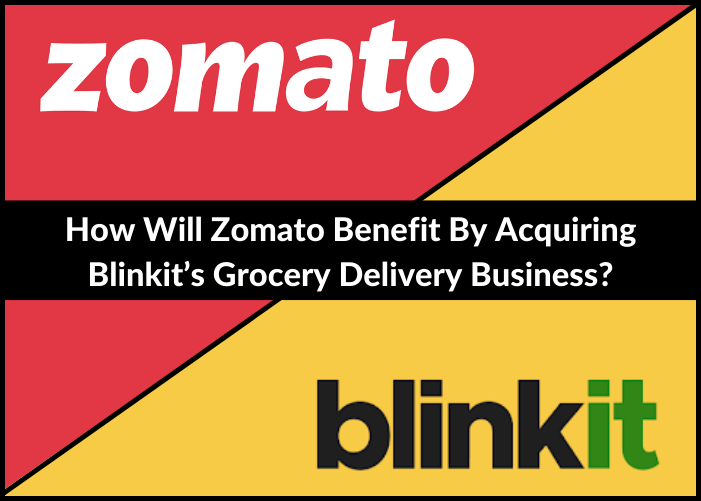Summary
Zomato has joined the frenetic dash for quick-commerce success by acquiring Blinkit. With this, it attempts to catch up with Swiggy, and a host of other younger startups in the quick-commerce segment, as it looks to expand its core business of food delivery.
After announcing its all-stock deal for $569 million, Zomato’s current guiding directive appeared to be “experimenting with a lot and retaining what works”.
In announcing the deal, Deepinder Goyal (Founder and CEO of Zomato), claimed that quick commerce had been a priority since the previous year and that the delivery business is wholly synergistic with the food delivery of Zomato, which augurs well for both in the long-haul.
Albinder Dhindsa (CEO, BlinkIt) will continue heading the business and the company would be kept separate. This stems from the logic that ‘super brands’ tend to perform better in India as compared to ‘super apps’.
While customers associate Zomato with ‘food’, BlinkIt represents ‘groceries and supplies.” For future growth and profitability, both will benefit from the other’s visibility and customer base.
What is BlinkIt?
- A quick-commerce on-demand marketplace that promises delivery of groceries and household supplies within 15 minutes.
- Founded in 2013 as Grofers, it quickly rose to become BigBasket’s rival with regard to next-day delivery.
- From quick commerce, it pivoted to next-day delivery and rechristened itself to BlinkIt. Its mission is to deliver groceries “in the blink of an eye.”
- Turned unicorn in August 2021. Although still a loss-making firm, Blinkit has displayed rapid growth after it pivoted.
Zomato + BlinkIt: aiming for success in quick-commerce
Blinkit’s acquisition is another fairly long line of investments that Zomato has made in recent years, some of the earlier ones being MagicPin, UberEats India, Shiprocket, Curefit, etc. The acquisition comes as a major relief for Blinkit, running as if it were at a loss, having to lay off several workers, making delayed payments, and shutting down some of its dark stores.
The quick-commerce marketplace has heated up in recent times. With the mantra of “10-minute delivery” on offer 24*7, it seems to have struck a chord with the consumer. With increased demand, naturally, will arrive competition and there is now a slew of players competing for market share in this hyper-competitive space. Some popular names are Dunzo, Instamart, and Swiggy.
Zomato believes that since the quick-commerce space forms a natural extension to their business of food delivery and both of them operate on a hyperlocal model, the merger brings synergies required to achieve a higher share of wallet and greater customer engagement.
How will the BlinkIt acquisition benefit Zomato?
1) Asset (delivery fleet) utilization: Acquiring a grocery delivery business should increase the range of operations that Zomato has, i.e., it has a larger product (offering) portfolio that covers a greater percentage of a 24-hour span and more use-cases. Food delivery is something that peaks at meal times, weekends (etc.), whereas grocery delivery has its own peak and non-peak hours. Thus, profitability improves, asset (fleet) utilization is better, and this improves the cost-benefit ratio.
2) Convenience of ‘15-minute delivery’: The monthly order frequency on Blinkit in May 2022 was 3.5 times, and is higher than that of Zomato’s food deliveries.
Customer metrics have shown distinct trends that customers, spurred by the convenience of the ‘15-minute delivery’, are motivated to shop spontaneously, even impulsively. Therefore, Zomato’s addressable market should see a healthy expansion through the addition of Blinkit’s quick-commerce.
3) Build vs. Buy: Blinkit has built key infrastructures such as a robust technology platform, strong third-party tie-ups, an elaborate dark-storage network, and a business that has achieved credible scale.
Now, Zomato would have to invest a huge amount of time and money – not to mention energy! – in building something like Blinkit. Therefore, they chose to go the oft-traveled route of ‘buy’ instead of ‘build’. Team and speed appear to be the two leading reasons that would have motivated Zomato to do so.
Further, instead of creating an additional drain on resources that would have been required to manage the grocery-delivery business, Blinkit’s acquisition brings with it an existing and suitably experienced, team that is already operational.
4) Synergistic: Zomato’s management team has clearly stated that success in quick-commerce cannot be driven purely by hyperlocal delivery. Blinkit, with its in-depth understanding of supply-chain networks, extensive customer base, elaborate dark-store network, relationships with vendors and sellers, and robust tech stack, would add to the extensive hyperlocal delivery network that Zomato has.
5) Ad Revenue: Zomato believes that Blinkit’s potential for ad revenue – an all-important revenue stream for companies like this – is greater than its own.
Although there exists a significant overlap in the customer segments of both, data and market-insight indicate that older sets of users that aren’t yet using Zomato’s food-delivery service, are already using Blinkit.
Zomato also believes that ad revenue is higher in quick-commerce as compared to food delivery simply because consumer brands and packaged goods have much larger digital media spends as compared to restaurants and cloud kitchens.
6) BlinkIt’s Numbers: Blinkit pivoted to quick-commerce in January 2022. By May 2022, its GOV (gross-order value) rose by 35% . According to data presented by Zomato, Blinkit’s revenue grew by more than 160%. On the back of such numbers, Zomato believes that the merger is slated for success.
Quick-commerce success factors: who has what
Blinkit:
- Strong tech-stack: As mentioned above, Blinkit has a robust tech stack that manages end-to-end last mile operations.
- Dark store network: Blinkit’s elaborate network of warehouses and dark stores (approximately 3,000 sq. ft each)
- Sourcing: Blinkit’s strong 3rd party and seller relationships
Zomato:
- Low CAC: Zomato has a broad base of customers (approximately 16 million) that transact with it every month.
- Last-mile delivery: Zomato has 316,000 delivery partners that form an extensive network across 1,000+ cities and towns.
- Repeat Behavior: Both customers of both platforms have displayed a healthy pattern of repeat purchases. Integrated membership programs go a long way towards encouraging this, too.
Conclusion: As is evident, quick commerce is growing rapidly in India. Numerous traditional stores that operated on the brick-and-mortar model are going the Ecommerce way and deploying modern tech tools, platforms, and systems like last mile delivery software. Zomato’s dive into quick commerce seems like a logical one at this stage.




